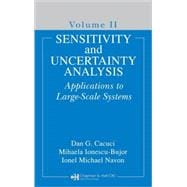
Note: Supplemental materials are not guaranteed with Rental or Used book purchases.
Purchase Benefits
What is included with this book?
| I. A COMPARATIVE REVIEW OF SENSITIVITY AND UNCERTAINTY ANALYSIS METHODS FOR LARGE-SCALE SYSTEMS | 1 | (36) | |||
|
5 | (21) | |||
|
5 | (1) | |||
|
6 | (10) | |||
|
16 | (1) | |||
|
16 | (5) | |||
|
21 | (5) | |||
|
26 | (6) | |||
|
26 | (3) | |||
|
29 | (2) | |||
|
31 | (1) | |||
|
32 | (5) | |||
| II. APPLICATIONS OF THE ADJOINT SENSITIVITY ANALYSIS PROCEDURE (ASAP) TO TWO-PHASE FLOW SYSTEMS | 37 | (86) | |||
|
38 | (17) | |||
|
39 | (1) | |||
|
40 | (6) | |||
|
46 | (1) | |||
|
47 | (8) | |||
|
55 | (68) | |||
|
57 | (8) | |||
|
65 | (15) | |||
|
80 | (2) | |||
|
82 | (9) | |||
|
91 | (32) | |||
| III. FORWARD AND ADJOINT SENSITIVITY ANALYSIS PROCEDURES FOR AUGMENTED SYSTEMS | 123 | (48) | |||
|
124 | (24) | |||
|
124 | (7) | |||
|
131 | (12) | |||
|
143 | (5) | |||
|
148 | (23) | |||
|
148 | (10) | |||
|
158 | (13) | |||
| IV. FORWARD AND ADJOINT SENSITIVITY ANALYSIS PROCEDURES FOR RESPONSES DEFINED AT CRITICAL POINTS | 171 | (60) | |||
|
172 | (22) | |||
|
174 | (3) | |||
|
177 | (4) | |||
|
181 | (2) | |||
|
183 | (11) | |||
|
194 | (37) | |||
| V. USING THE ASAP TO GAIN NEW INSIGHTS INTO PARADIGM ATMOSPHERIC SCIENCES PROBLEMS | 231 | (52) | |||
|
232 | (5) | |||
|
237 | (11) | |||
|
248 | (11) | |||
|
250 | (3) | |||
|
253 | (5) | |||
|
258 | (1) | |||
|
259 | (3) | |||
|
262 | (8) | |||
|
270 | (13) | |||
|
275 | (3) | |||
|
278 | (1) | |||
|
278 | (3) | |||
|
281 | (2) | |||
| VI. ADJOINT SENSITIVITY ANALYSIS PROCEDURE FOR OPERATIONAL METEOROLOGICAL APPLICATIONS | 283 | (60) | |||
|
283 | (23) | |||
|
284 | (4) | |||
|
288 | (18) | |||
|
306 | (13) | |||
|
307 | (3) | |||
|
310 | (9) | |||
|
319 | (24) | |||
|
320 | (3) | |||
|
323 | (4) | |||
|
327 | (16) | |||
| REFERENCES | 343 | (8) | |||
| INDEX | 351 |
The New copy of this book will include any supplemental materials advertised. Please check the title of the book to determine if it should include any access cards, study guides, lab manuals, CDs, etc.
The Used, Rental and eBook copies of this book are not guaranteed to include any supplemental materials. Typically, only the book itself is included. This is true even if the title states it includes any access cards, study guides, lab manuals, CDs, etc.